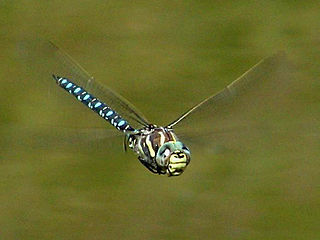
Odonata is an order of predatory flying insects that includes the dragonflies and damselflies. The two major groups are distinguished with dragonflies (Anisoptera) usually being bulkier with large compound eyes together and wings spread up or out at rest, while damselflies are usually more slender with eyes placed apart and wings folded together along body at rest. Adult odonates can land and perch, but rarely walk.

A dragonfly is a flying insect belonging to the infraorder Anisoptera below the order Odonata. About 3,000 extant species of dragonflies are known. Most are tropical, with fewer species in temperate regions. Loss of wetland habitat threatens dragonfly populations around the world. Adult dragonflies are characterised by a pair of large, multifaceted, compound eyes, two pairs of strong, transparent wings, sometimes with coloured patches, and an elongated body. Many dragonflies have brilliant iridescent or metallic colours produced by structural coloration, making them conspicuous in flight. An adult dragonfly's compound eyes have nearly 24,000 ommatidia each.

Damselflies are flying insects of the suborder Zygoptera in the order Odonata. They are similar to dragonflies but are usually smaller and have slimmer bodies. Most species fold the wings along the body when at rest, unlike dragonflies which hold the wings flat and away from the body. Damselflies have existed since the Late Jurassic, and are found on every continent except Antarctica.

In biology, a nymph is the juvenile form of some invertebrates, particularly insects, which undergoes gradual metamorphosis (hemimetabolism) before reaching its adult stage. Unlike a typical larva, a nymph's overall form already resembles that of the adult, except for a lack of wings and the emergence of genitalia. In addition, while a nymph moults, it never enters a pupal stage. Instead, the final moult results in an adult insect. Nymphs undergo multiple stages of development called instars.
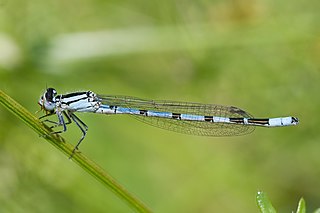
Enallagma cyathigerum is a species found mainly between latitudes 40°N and 72°N; It is widely distributed in the Palearctic, and the Nearctic species Enallagma annexum was at one time considered to be synonymous with it. The species can reach a length of 32 to 35 mm. It is common in many different countries including Russia, Sweden, Norway, Finland, the United States of America, and South Korea. Damselflies are an important link between the health of the aquatic ecosystem and its response to climate change.

Coenagrionidae or are a family of damselflies, also known as pond damselfies, in the order Odonata and the suborder Zygoptera. The Zygoptera are the damselflies, which although less known than the dragonflies, are no less common. More than 1,300 species are in this family, making it the largest damselfly family. The family Coenagrionidae has six subfamilies: Agriocnemidinae, Argiinae, Coenagrioninae, Ischnurinae, Leptobasinae, and Pseudagrioninae.
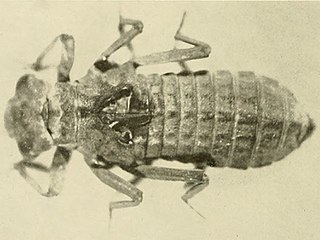
Epiophlebia laidlawi, the Himalayan relict dragonfly, is one of four species of Epiprocta in the family Epiophlebiidae. They have at one time been classified as a suborder Anisozygoptera, considered as intermediate between the dragonflies and the damselflies, partly because the hind wings and fore wings are very similar in size and shape, and partly because the insect at rest holds them back over the body as damselflies do. These attributes now are known to be misleading however; the genus Epiophlebia shares a more recent ancestor with dragonflies and became separated from other Anisoptera in and around the uplifting Himalayas.
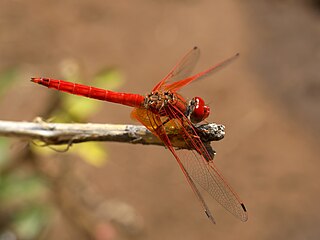
Epiprocta is one of the two extant suborders of the Odonata, which contains living dragonflies (Anisoptera), as well as Epiophlebioptera, which has a single known living genus Epiophlebia. Crown group Epiprocta first appeared during the Early Jurassic. It was proposed in 1992 by Heinrich Lohmann to accommodate the inclusion of the Anisozygoptera. The latter has been shown to be not a natural suborder, but rather a paraphyletic collection of lineages, so it has been combined with the previous suborder Anisoptera, the well-known dragonflies, into the Epiprocta. The old suborder Anisoptera is proposed to become an infraorder within the Epiprocta, whereas the "anisozygopterans" included here form the infraorder Epiophlebioptera. In Lohmann's original circumscription of the Epiprocta he also included the Tarsophlebiidae in it but Rehn (2003) placed it among the Zygoptera.
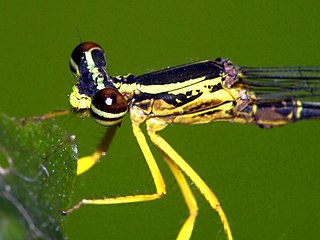
The Platycnemididae are a family of damselflies. They are known commonly as white-legged damselflies. There are over 400 species native to the Old World. The family is divided into several subfamilies.
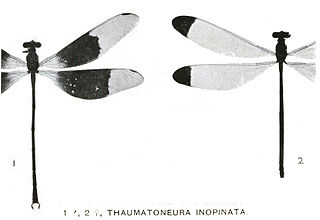
Thaumatoneura inopinata is a species of damselfly, sometimes called the cascade damselfly or giant waterfall damsel, and the only member of the genus Thaumatoneura. It is unusual in flying among the falling water and spray from waterfalls in moist tropical or subtropical forests in Costa Rica.

Ceriagrion cerinorubellum, commonly known as the orange-tailed marsh dart or bi-coloured damsel, is a medium-sized damselfly in the family Coenagrionidae. It is a very common species of damselflies in Asia.
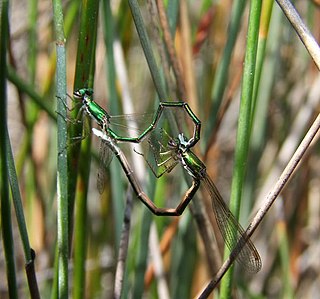
Hemiphlebiidae is a family of damselflies. It contains only one extant species, the ancient greenling, native to Southern Australia and Tasmania. The fossil record of the group extends back to the Late Jurassic, making them the oldest known crown group damselflies.

Epiophlebia superstes, the Japanese relict dragonfly, is one of the four species of the genus Epiophlebia, belonging to the family Epiophlebiidae, which is itself the sole living representative of the epiproctan infraorder Epiophlebioptera.

The Stenophlebiidae is an extinct family of medium-sized to large fossil odonates from the Upper Jurassic and Cretaceous period that belongs to the damsel-dragonfly grade ("anisozygopteres") within the stem group of Anisoptera. They are characterized by their long and slender wings, and the transverse shape of the discoidal triangles in their wing venation.

Calocypha laidlawi, or myristica sapphire, is a rare species of damselfly belonging to the family Chlorocyphidae. It is found only from Karnataka and Kerala in South India.

Calocypha is a genus of jewel damselfly in the family Chlorocyphidae. There are at least two described species in Calocypha.
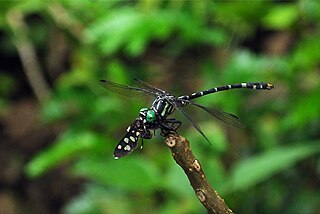
Nychogomphus striatus is a species of dragonfly in the family Gomphidae. It is endemic to the streams of Western Ghats of India. Reports from Nepal require further studies.
2015 in paleoentomology is a list of new fossil insect taxa that were described during the year 2016, as well as other significant discoveries and events related to paleoentomology that were scheduled to occur during the year.


















